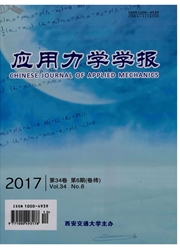

 中文摘要:
中文摘要:
利用Hamilton正则方程建立了由1个刚体、3个支座和2根弹簧组成的简单Hamil—ton系统的数学模型,并讨论了系统的实际结构与数学模型之间的差异;利用Lyapunov第一近似理论分析了系统的平衡态的稳定性,研究了系统的分岔.研究结果表明,刚体的转角受到支座、弹簧的3种限制:当弹簧刚度、自然长度、刚体重量和刚体中心与中间支座的距离满足一定条件时,系统只有1个平衡态,而且平衡态是稳定的;当弹簧刚度、自然长度、刚体重量和刚体中心与中间支座的距离不满足这一条件时,原来的平衡态变为鞍点而失去稳定性,同时分支出2个对称的平衡态,并且这2个平衡态是稳定的;系统发生叉形分岔.
 英文摘要:
英文摘要:
The mathematical model for a simple mechanical system consisting of a rigid body, three supports and two springs was established by using Hamiltonian canonical equations. The differences between the mathematical model and real system were discussed. Lyapunov's first approximate theory was used to analyze the stability of the balance states of the mechanical system, and the bifurcation of the mechanical system was systematically studied. It was shown that when the stiffness and initial length of the springs, the weight of the rigid body, and the distance between the gravity center of the rigid body and the mid support satisfy a certain condition, only one balance state exists in the mechanical system, and it is center and stable; if else, the balance state becomes a saddle point and is unstable; meanwhile, two new balance states are branched out, and they are stable; forked bifurcation exists in the simple mechanical system.
 同期刊论文项目
同期刊论文项目
 同项目期刊论文
同项目期刊论文
 期刊信息
期刊信息
